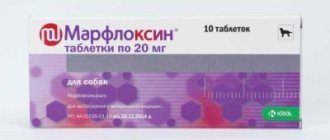Description of the antibiotic
Baytril is an antibiotic belonging to the group of fluoroquinolones. Its mechanism of action is aimed at destroying bacteria at the DNA level. The drug is active against streptococci, staphylococci, salmonella, mycoplasmas, etc. The medicine begins to act approximately half an hour after use, the effect persists throughout the day.
Veterinarians often prescribe Baytril to dogs for diseases caused by pathogens that are sensitive to the active substance of the antibiotic. Indications for use:
- respiratory diseases, including pneumonia;
- infections of the skin and soft tissues - abscess, phlegmon, infected wounds;
- pathologies of the urinary system, including cystitis;
- diseases of the ENT organs, such as otitis media;
- intestinal infections, including diarrhea of bacterial origin.
When is it used?
The drug has a wide spectrum of action. The instructions indicate that Baytril for dogs is prescribed for diseases caused by harmful bacteria of the respiratory, genitourinary and other systems. Typically, the medication is used to treat the following respiratory diseases:
- tracheitis;
- rhinitis;
- laryngitis;
- bronchitis;
- pneumonia, etc.
The medicine is also successfully used for other pathologies:
- with streptococcosis;
- with colibacillosis;
- with glomeluronephritis;
- for salmonellosis;
- with purulent inflammation of the bladder;
- with septicemia;
- for various mycoses;
- for dysentery;
- with phlegmon;
- with balanoposthitis, etc.
The antibiotic can also be used to treat secondary infections in viral diseases and pathologies caused by pathogens sensitive to enrofloxacin.
Despite its wide spectrum of action, it is impossible to use the drug without consulting a doctor and establishing an accurate diagnosis. If the pathology is not caused by an infection, its course may worsen. Do not self-medicate.
Composition and expiration date
Baytril has a therapeutic effect thanks to its active ingredient enrofloxacin. Additional components of the medicinal composition are potassium oxide, water for injection and butyl alcohol.
The medicine retains its medicinal properties for 3 years from the release date indicated by the manufacturer on the packaging. But this shelf life applies only to medications in original packaging. Once the bottle is opened, the shelf life is limited to 28 days.
In order for the drug to remain suitable for use, it is necessary to ensure correct storage conditions:
- ambient temperature +5…+25°C;
- a place protected from daylight penetration.
If the solution becomes cloudy or contains some impurities, it should not be used.
Pharmacological properties
The main active ingredient is enrofloxacin, which belongs to the group of antibacterial drugs of the fluoroquinolone group, has a wide spectrum of action, antibacterial and antimycoplasma effect, suppresses most gram-positive and gram-negative bacteria. The mechanism of action of enrofloxacin is to inhibit the activity of the gyrase enzyme, which affects cell replication in the DNA helix of the bacterial pathogen nucleus. When administered parenterally, Baytril is well absorbed and penetrates into all organs and tissues of the animal’s body in a short time. The maximum concentration is reached 20-40 minutes after administration, the therapeutic concentration is maintained for 24 hours after injection. Baytril in recommended doses is well tolerated by sick animals and does not have teratogenic, hepatotoxic or embryotoxic effects. Enrofloxacin is excreted in the urine, usually unchanged. The drug is partially metabolized to ciprofloxacin and excreted in feces and urine.
Instructions for use
Injection
The drug is offered in the form of an injection solution in dosages of 25 and 50 mg of the active substance.
This form of release is good because the medicinal composition quickly enters the body and begins to act. The disadvantages include the fact that not every owner will be able to give an injection to their pet, so they have to go to the veterinary clinic every day.
Dosage
The dosage of the medicine depends on the dog’s weight and is 5 mg per 1 kg of pet’s body weight:
- when using 2.5% Baytril - 0.2 ml of the medicinal composition per 1 kg of pet’s weight;
- when using 5% Baytril - 1 ml per 10 kg.
How to give an injection?
The injection is given at the withers. The solution is introduced slowly. The injection site should be changed. Frequency: 1 time per day at the same time.
The duration of treatment depends on many factors, including the clinical picture of the disease, and is determined by a veterinarian. The course recommended by the instructions is 3-10 days.
For oral use
Baytril, available as an oral solution, is not used in the treatment of dogs.
Pills
1 tablet contains 15 mg of enrofloxacin. The recommended daily dosage for dogs is 5 mg per 1 kg of dog weight, i.e. 1 tablet per 3 kg of body weight.
This form of release is convenient because the owner, without medical skills, can give medicine to the pet, which cannot be said about injections. But getting a dog to take medication is quite difficult. It is best to use a special device - a tablet dispenser. You can also mix the medicine with food or your favorite treat.
It is recommended to give tablets once a day. Duration of therapy – 3 days. If no improvement is observed, the doctor retests the sensitivity of the microflora to enrofloxacin and adjusts the course of treatment.
Contraindications
The drug "Baytril" is not allowed for use in cats and dogs under one year of age. Contraindicated for pregnant and lactating females. Not applicable to animals with disorders in the development of cartilage tissue or with an affected nervous system. Antagonistic effects may (rarely) occur with the combination of chloramphenicol or tetracycline and enrofloxacin (Baytril). Theophylline should not be used at the same time. Not used in parallel with anti-inflammatory and non-steroidal drugs.
Side effects
Baytril is a potent drug, so side effects may develop while taking it. Most often they manifest themselves as nausea and vomiting, diarrhea, and loss of appetite.
If unpleasant symptoms appear, you should stop taking the medication, give your dog an antihistamine and contact a veterinarian. Symptomatic treatment may be needed.
If the medicinal composition is administered quickly, a compaction occurs at the injection site. This can lead to unpleasant consequences, such as hair loss. A specialist must give the injection, so it is better to go to the clinic.
When should you not use it and what could be the consequences?
The use of Baytril for dogs is unacceptable in the following cases:
- puppies up to 1 year, until the bone skeleton is fully formed;
- during pregnancy;
- for diseases of the nervous system accompanied by seizures;
- during lactation;
- in case of intolerance to components;
- for pathologies of cartilage tissue.
You should also avoid using it if the disease is caused by microorganisms resistant to the drug.
Note! It is strictly forbidden to use Baytril in combination with tetracycline, macrolides, chloramphenicol and non-steroidal anti-inflammatory drugs.
Baytril has a strong effect on the animal's body and can cause side effects. They usually manifest as digestive problems. The animal may experience:
- vomit;
- nausea;
- loose stools;
- lack of appetite and other symptoms.
An antibiotic can also cause an allergic reaction, which is manifested by skin rashes, redness, itching, problems with respiratory function, and so on. If negative reactions of the body occur, the drug should be stopped, and the animal should be given an antihistamine and symptomatic treatment should be used.
If the medication is administered too quickly or incorrectly, lumps may occur at the injection site. They easily turn into septicemia, which can cause hair loss and other problems. If you do not have sufficient experience, it is better to entrust the injections to a doctor.
Reviews
Owners
Kirill, 31 years old, Blagoveshchensk : “Baytril was prescribed to our Pekingese after he was diagnosed with pneumonia. But after 2 injections, the dog became apathetic, refused to eat, stopped moving - he just lay there and that’s it. We immediately contacted the veterinarian. He said the dog was intolerant to the medication and prescribed a different antibiotic.”
Irina, 42 years old, Kaluga : “After the Baytril injection, the dog began to itch at the injection site. The next day the dog howled in pain after the injection. I had to give up the drug, so I can’t judge how effective this remedy is.
The drug was prescribed for purulent cystitis, but 2 injections were not enough. The doctor selected another medication.”
Veterinarians
Alexey, 37 years old, veterinarian, Rostov-on-Don : “Baytril is an effective drug that helps with many bacterial pathologies. But the medicine has many side effects, which dog owners often complain about.
Strict adherence to the doctor’s recommendations helps to avoid unpleasant symptoms. I don’t recommend giving injections yourself; it’s better to entrust it to a doctor.”
Victoria, 51 years old, veterinarian, Tambov : “I prescribe Baytril for dogs with urinary system infections. An effective medicine, but has side effects. I warn dog owners about this and recommend following the veterinarian’s recommendations.”
Indications for use
Baytril is used to treat cats suffering from diseases of viral and bacterial origin. It is recommended to use this medicine if your pet has the following diseases:
- skin diseases associated with infections;
- septicemia, leading to infection of the animal’s blood;
- colibacillosis, which is a dangerous disease, the symptom of which is profuse diarrhea, leading to a lack of water in the body and the death of the pet;
- salmonellosis is a disease of the digestive system that poisons and dehydrates the body;
Baytril for cats
- streptococcosis, affecting the respiratory, digestive systems and others;
- mixed infections;
- secondary infections in viral diseases;
- rhinotracheitis, runny nose;
- diseases of the stomach and intestines;
- cystitis, urolithiasis.
Important! This remedy can be used for preventive purposes after operations. It is given to cats and female cats who have undergone castration/sterilization and other surgical interventions on the body.
The drug begins to act after 20-30 minutes. after administration, instantly distributed throughout the tissues. After 24 hours, the medicine leaves the body along with the animal’s feces.
Cat after sterilization
Pharmacokinetics of Baytril in dogs
In dogs, the absorption and elimination characteristics of the oral formulation are linear (plasma concentrations increase proportionally to dose) when Baytril is administered at doses up to 11.5 mg/kg twice daily. Approximately 80% of an orally administered dose enters the systemic circulation unchanged. Eliminating organs, based on the time the drug is eliminated from the body, can easily remove the drug without evidence of accumulation.
The main route of elimination is through urine. Absorption and elimination characteristics beyond this point are unknown. Saturated absorption and/or elimination processes may occur at high doses.
Following an oral dosage for dogs of 2.5 mg/kg, baytril reached 50% of the maximum serum concentration after 15 minutes, and the maximum serum level was reached after one hour. The half-life in dogs is approximately 2 hours at this dose. Baytril is an antibacterial injection solution 2.27% for dogs.
Contraindications to the use of the drug in dogs
Baytril is contraindicated in dogs with hypersensitivity to quinolones.
The use of Baytril is contraindicated in small and medium breed dogs during the rapid growth phase (2 to 8 months of age). Safe use of Baytril has not been established in large and giant breed dogs during the rapid growth phase. Large breeds can remain in this phase for up to one year, and giant breeds for up to 18 months. In clinical field trials using a daily oral dose of 5.0 mg/kg, there were no reports of lameness or joint problems in any breed. However, controlled studies with histological examination of articular cartilage have not been performed in large or giant breeds.
Dosage and Administration
Baytril injection solution can be used as a starting dose of 2.5 mg/kg.
It should be administered intramuscularly as a single dose, after which Baytril tablet therapy should be started.
The lower end of the dose range was based on efficacy studies in dogs where Baytril was administered at a dose of 2.5 mg/kg twice daily. Targeted animal safety and toxicological studies were conducted to establish the upper limit of the dose range and duration of treatment. Use the drug within 90 days after the first puncture of the bottle. It is not permissible to use more than 20 punctures of a bottle with the drug.
DRUG INTERACTIONS
Concomitant therapy with other drugs that are metabolized by the liver may decrease the rate of clearance of the quinolone and the other drug.
Baytril was administered to dogs at a daily dose of 10 mg/kg concomitantly with a wide range of other drugs, including anthelmintics (praziquantel, febantel), insecticides (pyrethrins), heartworm preventatives (diethylcarbamazine) and other antibiotics (ampicillin, gentamicin sulfate, penicillin) . Currently, there is no known incompatibility with other medicinal products.
Dog safety
Adult dogs treated with oral Baytril at a daily dose of 52 mg/kg for 13 weeks had only isolated cases of vomiting and loss of appetite. Adult dogs receiving tablets and administration of the drug for 30 consecutive days with daily treatment of 25 mg/kg did not show significant clinical signs and had no effect on blood parameters. Daily doses of 125 mg/kg for up to 11 days caused vomiting, appetite, depression, difficulty ambulating in dogs, and death, while adult animals receiving 50 mg/kg/day for 14 days had clinical signs of vomiting and appetite.
Adult dogs treated with three intramuscular treatments of 12.5 mg/kg followed by 57 oral treatments of 12.5 mg/kg at 12-hour intervals showed no significant clinical signs or effects on clinical chemistry, hematology or histological parameters.
Oral treatment of growing puppies aged 15 to 28 weeks with a daily dosage of 25 mg/kg caused abnormal development of the carpal joint and weakness in the hind limbs. Significant improvement in clinical signs is observed after discontinuation of the drug. Microscopic studies revealed damage to articular cartilage after 30 days of treatment at 5, 15 or 25 mg/kg in this age group. Clinical signs of difficulty walking or associated cartilage lesions were not observed in puppies 29 to 34 weeks of age following daily treatment with 25 mg/kg for 30 consecutive days, nor in puppies 2 weeks of age on the same treatment schedule.
The drug does not affect circulating microfilariae.
No adverse effects on reproductive parameters were observed in dogs.










